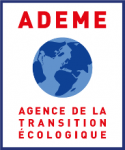Mangrove Blue carbon in Brazil
| ABG-133425 | Thesis topic | |
| 2025-09-16 | Public funding alone (i.e. government, region, European, international organization research grant) |
- Ecology, environment
- Chemistry
Topic description
RATIONALE
Mangrove ecosystems absorb CO2 from the atmosphere, and bury carbon at a rate ten times faster than terrestrial forests1. Therefore, mangroves are part of the “blue carbon” ecosystems, strong allies for mitigating climate change. Despite their exceptionally high carbon stocks and sink2,3, mangroves have been relatively little studied compared to terrestrial ecosystems. The mechanisms regulating soil organic matter (SOM) stabilisation in mangroves remain largely unknown4–6. SOM recalcitrance to microbial decomposition and anoxic conditions have been shown as major determinants of SOM decay in waterlogged mangrove soils5,7. Yet, SOM accessibility to soil microorganisms might also explain the long-term storage of carbon (i.e. century to millennia) in mangroves5,8 as for terrestrial9,10 and marine ecosystems11,12. SOM stabilisation may be influenced by mangrove geomorphological settings13 because they lead to differences in soil mineralogy, organic matter quality, and oxic/anoxic conditions, all of which influencing SOM inaccessibility to microbes.
The main objective of this PhD thesis will be to investigate the potential carbon stabilisation processes and the microbial composition and activity across contrasted mangrove sites, with a focus on Brazilian mangroves.
The results will be helpful for policy makers and NGOs to understand the perenniality and heterogeneity of blue carbon across mangroves.
METHODS
The post-graduate student will sample soils in Brazilian mangroves, and analyse SOM protection with different state of art laboratory methods (microbiology, soil biogeochemistry). She/he/they will use density fractionation to separate easily decomposable plant litter from stabilised SOM in interaction with the mineral phase. Moreover, she/he/they will characterise the degree of stabilisation of different SOM types by investigating the elemental and isotopic composition of the different fractions, and also study microbial processes.
SUPERVISORY TEAM
Dr. Cornelia RUMPEL (She/her), Dr Marie ARNAUD (She/her); Dr Tiago Osorio Ferreira (He/him), Dr Francisco Ruiz (He/him)
APPLICATION
The offer will be closed in the 2d of November.
Fill the form here: https://forms.gle/kTaTuefxh7QN9Ky7A
(You need a gmail account to connect)
SALARY and BENEFITS
- 2200 € gross monthly (~1700 net)
- 5 weeks of paid holidays
- 50% paid for Navigo Pass
- Include national health insurance and 50% contribution for private health insurance (mutuelle)
- Annual bonus for sustainable mobility
- Retirement pension scheme
- Free training course (Hard and Soft skills)
REFERENCES
- 1. McLeod, E. et al. A blueprint for blue carbon: Toward an improved understanding of the role of vegetated coastal habitats in sequestering CO2. Front. Ecol. Environ. 9, 552–560 (2011).
- 2. Middleton, B. A. & McKee, K. L. Degradation of mangrove tissues and implications for peat formation in Belizean island forests. J. Ecol. 89, 818–828 (2001).
- 3. Alongi, D. M. The energetics of mangrove forests. (Springer, 2009). doi:10.1007/978-1-4020-4271-3.
- 4. Arnaud, M., Baird, A. J., Morris, P. J., Dang, T. H. & Nguyen, T. T. Sensitivity of mangrove soil organic matter decay to warming and sea level change. Glob. Chang. Biol. 26, 1899–1907 (2020).
- 5. Spivak, A. C., Sanderman, J., Bowen, J. L., Canuel, E. A. & Hopkinson, C. S. Global-change controls on soil-carbon accumulation and loss in coastal vegetated ecosystems. Nat. Geosci. 12, 685–692 (2019).
- 6. Macreadie, P. I. et al. The future of Blue Carbon science. Nat. Commun. 10, 3998 (2019).
- 7. Kristensen, E., Bouillon, S., Dittmar, T. & Marchand, C. Organic carbon dynamics in mangrove ecosystems: A review. Aquat. Bot. 89, 201–219 (2008).
- 8. Basile-Doelsch, I., Balesdent, J. & Pellerin, S. Reviews and syntheses: The mechanisms underlying carbon storage in soil. Biogeosciences 17, 5223–5242 (2020).
- 9. Schmidt, M. W. I. et al. Persistence of soil organic matter as an ecosystem property. Nature 478, 49–56 (2011).
- 10. Rothman, D. H. & Forney, D. C. Physical Model for the Decay and Preservation of Marine Organic Carbon. Science (80-. ). 316, 1325–1328 (2007).
- 11. Barber, A. et al. Preservation of organic matter in marine sediments by inner-sphere interactions with reactive iron. Sci. Rep. 7, 366 (2017).
- 12. Kida, M. & Fujitake, N. Organic Carbon Stabilization Mechanisms in Mangrove Soils: A Review. Forests 11, 981 (2020)
- 13. Arnaud, M., Lovelock, C.E., Maceiras, M. … Rumpel, C. The nature of soil blue carbon varies across mangrove geomorphic settings. Commun Earth Environ 6, 743 (2025).
Starting date
Funding category
Funding further details
Presentation of host institution and host laboratory
CONTEXT OF THE PHD
The doctoral student will be based at Sorbonne University, France. Sorbonne University (PSU) is a world-class, research-intensive institution, internationally recognised for excellence in environmental sciences and ranked among the top 100 global universities. The doctoral thesis will be part of an international project between the USP and the CNRS, comprising two doctoral projects. These two theses will produce highly complementary results, and the two doctoral students will work closely together. They will share basic data on the physicochemical parameters of soils and their pedogenic environment. This will allow them to co-author articles from both doctoral projects. Regular meetings with the thesis supervisors and joint thesis committees will enrich the overall understanding of the system acquired by the two doctoral students. The doctoral student recruited by the CNRS will carry out his field and laboratory work in Brazil. The PhD student will benefit of being part of the international project TROPECOS. Start Date: January 2026 (the earliest)
Website :
Candidate's profile
REQUIREMENTS
Master completed in Soil Science, Environmental Sciences, Physical Geography, Chemical Oceanography, Coastal ecosystems or related fields.
Knowledge of coastal ecosystems and/or the soil carbon cycle.
International experience required
Willingness to national and international travel for sampling campaigns, meetings, and training activities.
Enthusiasm about laboratory soil analysis and repetitive tasks
Good English speaking/writing skill ( > B2 level, IELTS certificate appreciated).
Ability to conduct fieldwork in coastal and remote environments.
Vous avez déjà un compte ?
Nouvel utilisateur ?
Get ABG’s monthly newsletters including news, job offers, grants & fellowships and a selection of relevant events…
Discover our members
 ONERA - The French Aerospace Lab
ONERA - The French Aerospace Lab  SUEZ
SUEZ  Groupe AFNOR - Association française de normalisation
Groupe AFNOR - Association française de normalisation  ADEME
ADEME  Nokia Bell Labs France
Nokia Bell Labs France  Laboratoire National de Métrologie et d'Essais - LNE
Laboratoire National de Métrologie et d'Essais - LNE  TotalEnergies
TotalEnergies  PhDOOC
PhDOOC  Tecknowmetrix
Tecknowmetrix  Institut Sup'biotech de Paris
Institut Sup'biotech de Paris  ASNR - Autorité de sûreté nucléaire et de radioprotection - Siège
ASNR - Autorité de sûreté nucléaire et de radioprotection - Siège  ANRT
ANRT  MabDesign
MabDesign  Ifremer
Ifremer  Aérocentre, Pôle d'excellence régional
Aérocentre, Pôle d'excellence régional  CESI
CESI  MabDesign
MabDesign  Généthon
Généthon  CASDEN
CASDEN
